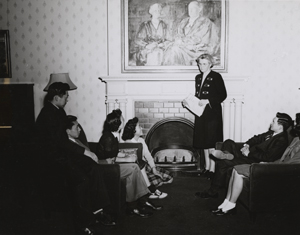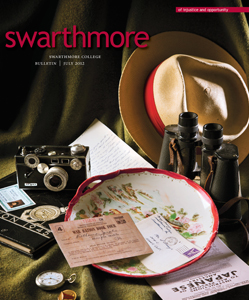WEB EXCLUSIVE: More stories about wartime at Swarthmore

Dean Frances Blanshard of Swarthmore College talks to a group of Nisei students in Parrish Parlors in January 1944. From left to right they are Tomomi Murakami; Warren Uchimoto, Kimi Nagatani, Miyoko Inouye, George Inouye, and Ruth Dohi.
“I yearn for my student days at Swarthmore,” says Warren Uchimoto ’45, a retired mechanical engineer, now 89 and living in a retirement community in Saratoga, Calif. Coming from Gila River camp, he says, “I remember the day I arrived by train at the College, late December 1942 or early 1943. It was evening, about 7 p.m., and someone told me how to get to Parrish Hall, where the dining room was. The girls’ dormitories were upstairs. Someone called Dean Everett Hunt down, so he came and welcomed me and assigned me my room—in Wharton. Later, I lived in Pittenger, and then in my last couple of semesters, I shared a suite in Roberts, which was nice, because we used one room for studying and one for sleeping. And we had a private bath. It was a very happy time for me. I really enjoyed the school and the professors and the courses I took. I majored in mechanical engineering.
I feel very appreciative that I was able to attend such a prestigious school, especially during such a difficult time. People were very kind. Marie Sullivan Patterson, a secretary for the Class of ’26, invited a group of us over for dinner, and the treasurer of the College Nicholas Pittenger and his wife, Cornelia, were very kind to the students from the relocation camps, hundreds of miles from home. They always made sure that we had somewhere to go for Thanksgiving or Christmas. I remember spending Christmas with them in 1943. Very fine people.”
Warren attended graduate school at the University of Michigan—“I think it might have helped that one of the young professors at Swarthmore was a Michigan graduate,” he said. He became a mechanical engineer at General Dynamics and later spent 30 years with Lockheed Martin, where his department manager was Robert Howell ’53, who became a good friend.
Warren recalls his only visit to campus around 1984, when General Dynamics sent him on a business trip to Philadelphia.
“It was really quite an experience—after 40 years. I had a very strange, sort of Rip Van Winkle feeling—was it possible that I was once really here? I wandered around the campus, dropped by and chatted with Dean Hunt, by then retired, living in a little house there. I visited the engineering building, the admissions office, and alumni relations and found that the only person I knew was Frances Shero, who, 40 years later, was still working there. I’d known her back in the 1940s when she was in her early 20s, and she looked quite different. We chatted for a while, and I started to see some of the old familiar hand gestures and thought, ‘Yes, this is little Fran.’”
Sadako Hayase Houghten ’47, now living in Seattle, was interned at Granada, a camp in Colorado, with her family before she came to the College. Although she finds it painful to talk of her wartime experiences, she still feels gratitude for the opportunity offered to her by President Nason.
“Swarthmore changed my life,” she said. “I got to go to college, which I probably would not have ended up doing otherwise, although, in retrospect, I do wish I’d majored in botany rather than zoology. I made some good friends at Swarthmore.” After graduating from Swarthmore, Sadako went to graduate school at the University of Ilinois–Urbana and obtained an M.Sc. in biology, later teaching that subject at Los Angeles Community College, a four-year night school.
Toshiyuki “Toshi” Fukushima ’51, now 90, lives in Swarthmore with his wife, Marion Macdaid Fukushima. Although physically frail, his mind is clear and he still has vivid memories of the camps. (Before our chat, he offered a little instruction on the correct pronunciation of Japanese names, especially his own.) Originally from Tacoma, Wash., he came to Swarthmore after the war. He had completed two years of an engineering degree at the University of Washington–Seattle before he and his mother were evacuated to an assembly center at the Western Washington Fairgrounds in Puyallup, Wash.
Toshi says, “We were allowed to take two suitcases each. We were housed in racetrack stables, where the planking wasn’t very good and the walls were partitions that didn’t reach the ceiling. And there were no facilities.” According to Part One of “The Stolen Years,” a two-part feature by Tom Griffin in the December 2005/March 2006 issues of Columns, the University of Washington alumni magazine, the Puyallup assembly center was, ironically, named Camp Harmony.
From there, he and his mother were taken to Minidoka in Idaho. “In the barracks where we lived, at least the walls reached up to the ceiling. It was more private, and we had common dining rooms and washrooms. And we were better off in Idaho than the evacuees in Arizona. The climate in Idaho was better.” He describes how, as soon as job openings became available in the camp, he went to work in an engineering office. He made friends with an architecture student, and they both joined the men’s choir.
Toshi was cleared to leave Minidoka in 1943. He came East and enrolled at the University of Maine. “It was January and really cold there. I had only two sweaters, and I couldn’t survive the weather,” he says. So he went to Philadelphia in September to work for the NJASRC. In 1949, he enrolled, as a junior, at Swarthmore and obtained a bachelor’s degree in mechanical engineering in 1951 and a master’s degree in 1959, while serving as an undergraduate instructor there.
In 2008, Toshi and 160 other University of Washington Nikkei students who had had to interrupt their college careers, received honorary degrees from the university in a special ceremony.
Yoneji Fukanaga ’46 is mentioned in captions although absent from actual photographs currently held in The Bancroft Library, UC–Berkeley, but no further accessible information could be found on him.
Kimi Nagatani ’46 passed away in 2007, leaving no known first-person records of her wartime experiences. According to newspaper clippings archived in the Swarthmore Friends Historical Library, she was the 1943 recipient of a $200 WSGA scholarship, a freshman award set up by the College on the condition that the WSGA would provide half the funding. In an obituary issued by the Orange County Friends Meeting, Nagatani, a native of Seattle, Wash., had attended college and business school there until her relocation to Manzanar and later Minidoka. During her internment, she taught shorthand to the internees. At Swarthmore, she majored in economics and, after graduation, she worked for the AFSC in Philadelphia and later as a relief worker assisting refugees in the Gaza Strip during 1949–1950. Her interest and concern in displaced persons and refugees led her to work in the U.N Office of the High Commissioner for Refugees in Geneva, Switzerland, and later pursue similar work in Africa and Europe. She served on the Board of Directors of the AFSC Philadelphia and as a representative of Pacific Yearly Meeting to Friends Committee on National Legislation, in Washington, D.C.
 Email This Page
Email This Page